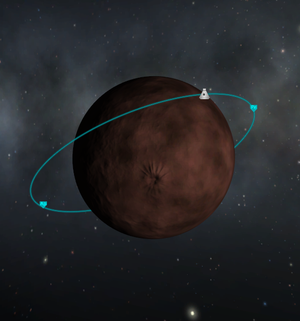Difference between revisions of "Orbit"
From Kerbal Space Program Wiki
(Replaced {{Delete}} with {{Stub}}) |
(Minor improvements.) |
||
| Line 1: | Line 1: | ||
{{Stub|physics}} | {{Stub|physics}} | ||
| − | + | [[File:MohoSmall.png|thumb|right|A spacecraft in orbit around [[Moho]].]] | |
| − | + | An '''orbit''' is an [[w:ellipse|elliptical]] path around a celestial body. The point on an orbit which is closest to the orbited body is called the ''periapsis''; the furthest point is the ''apoapsis''. | |
| − | An orbit is a | + | An orbit is considered "stable" if all points in the orbit are above the terrain and atmosphere of the orbited body. A spacecraft in such an orbit will not lose velocity due to atmospheric drag or collisions with terrain. |
| + | |||
| + | To achieve orbit, a spacecraft must reach a sufficient altitude and orbital velocity. During ascent, a [[gravity turn]] helps to achieve both of these goals in a fuel-efficient way. | ||
| + | |||
| + | == External links == | ||
| + | * [[w:Orbit|''Orbit'' article on Wikipedia]] | ||
| + | * [[w:Apsis|''Apsis'' article on Wikipedia]] | ||
Revision as of 17:20, 31 October 2012

A spacecraft in orbit around Moho.
An orbit is an elliptical path around a celestial body. The point on an orbit which is closest to the orbited body is called the periapsis; the furthest point is the apoapsis.
An orbit is considered "stable" if all points in the orbit are above the terrain and atmosphere of the orbited body. A spacecraft in such an orbit will not lose velocity due to atmospheric drag or collisions with terrain.
To achieve orbit, a spacecraft must reach a sufficient altitude and orbital velocity. During ascent, a gravity turn helps to achieve both of these goals in a fuel-efficient way.